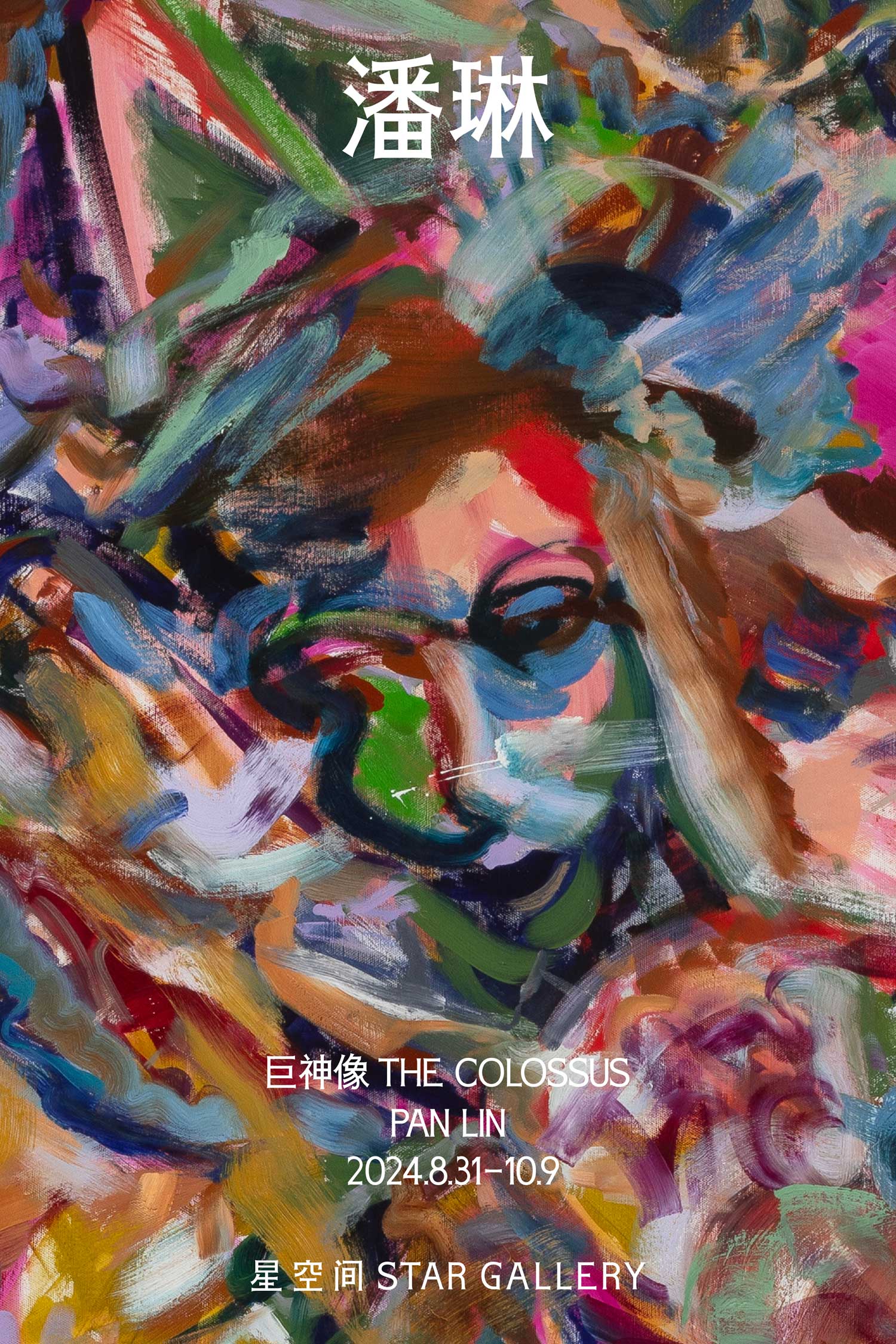展期 Period:
2024.8.31—2024.10.9
艺术家 Artist:
地点 Venue:
前言 Introduction:
我们欣然宣布将举行潘琳在星空间的第二次个展:巨神像(The Colossus),以呈现艺术家最新的创作动态和艺术进展,展期从8月31号持续至10月9号。
展览名为“巨神像”,其灵感来源于美国女诗人西尔维娅·普拉斯(Sylvia Plath)的同名诗作。在这首动人的诗篇中,诗人以一尊历经时光摧残后破损且半被掩埋的巨大雕像为喻体,来指涉她自己与父权制遗存、伟大诗歌传统之间的复杂关系,以及自己在这一过程中所逐渐意识到的创造者使命和主体性。在反复阅读诗歌的过程中,潘琳找到了深刻的共鸣。自幼习画的潘琳,曾经将绘画视为自己人生路上的亲密伙伴、唯一不能失却的庇护所;而今,随着创作状态的日渐自觉,这既呈现为画面上的视觉丰沛,也令她对自己与艺术的关系有了更强烈的体认和定位,恰如普拉斯为巨神像清理喉管的淤泥、使其内部空间到来一般,潘琳也总是从自己想画的画面一再驱向于未知的边缘,谋求感受力的综合传递。
这一变化,极其自然地契合着潘琳近期在绘画方法上的新试验,那就是诗歌阅读体验的加入。潘琳看似直截淋漓的画面,实际上并不是一挥而就的,而是经历了一系列她给自己制定的创作规则:这些规则一方面是对艺术家沉溺于自己的审美惯性的预防机制,比如以抽签或阅读诗歌的方式来为拼贴的底稿赋予色彩;另一方面,则使艺术家能够经历一个向内探寻的深入过程,从而在感官感觉的敏锐性和主体向未知自我的开放性探索之间,搭设起桥梁。在这一过程中,对诗歌的选择经历了和拼贴出底稿相似的灵感拂动,进而在对诗歌的反复阅读和背诵中,同时也调动起私人的情感记忆,最终形成对诗歌的理解,这一理解能够映照出艺术家与外界事物的内在,并将个体经验以一种凝缩(contraction)的形式返置入画面。在最终的视觉结果上,潘琳的画面保留了若干形象,但在根本上仍然是挣脱了叙事性的线条、色彩与空间关系,仅仅留给观者一鳞半爪的视觉化线索以及涌动的能量感,但这正好也是对观者自由挥发感性的空间予以保留。在这些画作中,艺术家的感性参与,在绘画的过程中被拉得更加细腻且迂回,并不像行动绘画一样直接地呈现出身体的痕迹,而是以自己的内在性为丹炉去进行熔炼和提取,将知觉的清晰和浑然时刻一并保留下来,这种方式非常接近德勒兹所说的“心灵的静观”,既使得艺术家得以从此前的格子或斜线的构图法则中越过,也使得绘画的基本语法在此承担了隐去私人叙述的功能。一旦开始讲述,那个发言的主体必然被刻画和定型,但相较于彰显主体,潘琳更在意的是表达那些相互串联的通感和背后的精神性,它们总是趋向于变化与逃逸。
在展厅中,观者难以辨认出其中隐藏了数首狄兰·托马斯(Dylan Thomas)的诗作并无大碍,观者可以辨认出同一个拼贴底稿诞生出不同的变体,但它们也仍然是一张张独立的绘画,恰如同一曲谱经历了不同的弹奏,同一食谱经历了不同地区风物的演绎,往往是感官的不确定性和变数才为我们带来可观的惊喜。潘琳这些似乎是成对绘制的画作,实际在数量上也可以趋于无穷。因为此处并不存在什么永恒不变的真理,只有凝缩为此刻的、活泼泼的生命观照。潘琳此刻面向了巨神像,是试图将生命本身的流动性,精湛地留存在平面上。
文/姚斯青
We are pleased to announce Pan Lin's second solo exhibition at Star Gallery, titled The Colossus, showcasing the artist's latest creative developments. The exhibition will run from August 31 to October 9.
The exhibition takes its name from the poem "The Colossus" by American poet Sylvia Plath. In this evocative work, Plath uses the image of a massive, time-worn statue, partially buried and eroded, as a metaphor for her complex relationship with patriarchal legacy and the grand tradition of poetry. Through repeated readings of the poem, Pan Lin found deep resonance with Plath's themes. Having studied painting since childhood, Pan once saw art as her closest companion and sole refuge. Now, with an increasing sense of purpose in her work, this is reflected not only in the visual richness of her paintings but also in a more profound understanding of her relationship with art. Much like Plath's attempt to clear the silt from the statue's throat to bring forth its inner space, Pan constantly pushes her work towards the unknown, seeking to convey a comprehensive sensory experience.
This evolution naturally aligns with Pan Lin's recent experiments in her painting methods, in incorporating her experiences with poetry. Although her paintings may appear straightforward and expressive, they are far from spontaneous creations. Instead, they are shaped by a series of self-imposed creative rules. These rules serve two purposes: first, they act as a safeguard against the artist's tendency to indulge in her aesthetic habits, using techniques like drawing lots or reading poetry to determine the colors for her collaged drafts. Second, they allow Pan to embark on an inward journey of exploration, bridging the gap between heightened sensory awareness and an open-ended search for her unknown self. In this process, the selection of poetry parallels the inspiration behind her collaged drafts, with repeated readings and recitations awakening personal emotional memories, ultimately forming a deeper understanding of the poetry. This understanding reflects the artist's inner relationship with the external world, compressing her personal experiences into a contraction that she then reintegrates into her paintings. The final visual results retain certain recognizable forms but fundamentally break free from narrative constraints, leaving viewers with only fragmented visual clues and a sense of dynamic energy. This approach preserves space for the viewer's own emotional response, as the artist's engagement with the work becomes more nuanced and indirect. Unlike action painting, which directly exhibits the traces of the artist's physical presence, Pan's work is a process of internal alchemy, blending clarity and obscurity within her perceptions. This method closely resembles what Deleuze refers to as the "contemplation of the mind," allowing the artist to transcend previous compositional rules and use the basic grammar of painting to obscure personal narratives. Once a story begins to be told, the subject inevitably becomes defined and fixed. However, rather than emphasizing the subject, Pan Lin is more concerned with expressing the interconnected synesthetic experiences and the underlying spirituality, which constantly tend towards change and escape.
In the exhibition space, it doesn't matter if viewers can't identify the hidden poems of Dylan Thomas within the paintings. What they can recognize is the different variations born from the same collaged draft, each still standing as an independent painting. Much like how a musical piece can be performed in various ways or how a recipe can be interpreted differently across regions, it is often the unpredictability and variability of sensory experiences that bring us the most delight. Though these paintings might seem to come in pairs, their potential for endless variations means that they are not finite in number. There is no eternal truth here, only a vivid, momentary contemplation of life. In this moment, Pan Lin faces the colossus, attempting to capture the fluidity of life on a two-dimensional surface.
Introduction by Yao Siqing

